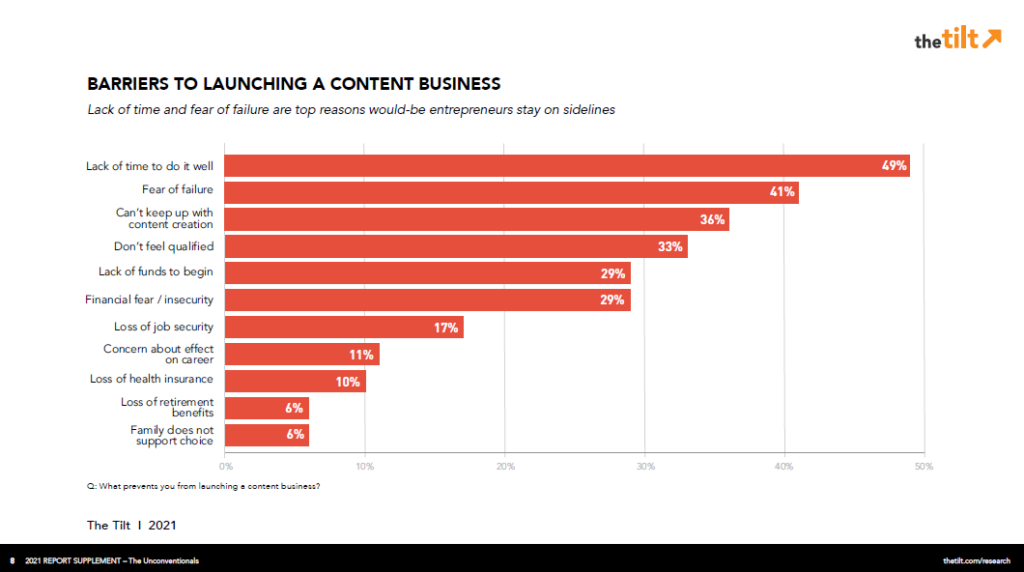You want to become a content entrepreneur. You already may have a good idea for a content business or you’re already creating and publishing some content. But you haven’t taken the plunge to launch a content business.
What are your content business barriers? That’s the question we posed in our content entrepreneur research, The Unconventionals: 2021 Content Entrepreneur Benchmark Research.
Here are the most popular reasons content creators don’t launch a content business:
- No. 1: Lack of time (49%)
- No. 2: Fear of failure (41%)
- No. 3: Can’t keep up with creating content (36%)
- No. 4: Don’t feel qualified (33%)
- No. 5 (tie): Lack of funds to begin and financial fear/insecurity (29%)
These six content business barriers fall into a few themes: time, confidence, and money.
Let’s look at how you can overcome each content business barrier.
Tilt Advice
Two of the top three reasons indicate content creators don’t think they have enough time to create a content business.
But first, you should get a better idea of what a content business means to you.
Joe Pulizzi’s Content Inc. model identifies seven steps to create a sustainable content business. At this point, estimate the time it will take you to execute the first three – identify your content sweet spot, find your content tilt, and start your base (one format and distribution channel). Though you might think you could do this in an hour, plan for longer. You should do research, engage in similar communities, talk to potential audience members, etc. If you haven’t done this, it could take well over 20 hours. (Everybody works at different paces and does research to varying depths, so there isn’t a standard number of hours.)
Want to launch a content business? Schedule time on your calendar to figure out your content sweet spot, #ContentTilt, and base, says @AnnGynn. #startup #entrepreneur Share on XOK, now, how do you find the time to do those first three phases? Though time is a must-have ingredient, for most creators, the real issue is about priorities.
We realize you probably can’t afford to quit your “day” job or abandon family responsibilities to spend all your working time on the content business. But what can you afford to quit doing?
Document how you spend your time for one week. Make a notation of everything you do that takes at least 10 minutes. At the end of the week, grab three highlighters or markers (green, yellow, red).
- Use the red one to underline or highlight everything you must do at the same time (i.e., work meetings, religious services). These are your non-negotiables.
- Use the yellow one to highlight everything you must do but have some flexibility in when or how you do it (i.e., laundry, exercising).
- Use the green one to highlight the things you don’t have to do (i.e., stream Netflix, dine with friends).
There are no wrong answers in this exercise — what might be a non-negotiable for you might not be the same for someone else. That’s OK. This is about what you want and are willing to do, not what you think you should be willing to do.
Decide how much time you're willing to commit to launch a content business, not what others expect you to do, says @AnnGynn. #contententrepreneur #creatoreconomy Share on XGo through every green-marked item and add up the available time. If you stop doing some of those items, will you have enough time to work on your content business? If the answer is no, proceed to the yellow-marked items. Are there things you could do less frequently or take less time to do? Could you rearrange these must-dos? For example, take 10 six-minute breaks and turn them into a single 60-minute block of free time that you could spend working on the business.
With this analysis, you can create a new calendar that allows more time to build your business and create content. More importantly, you can stop thinking that you don’t have “enough time” and make the most of the time you can devote. With this knowledge, you can develop your business – and content creation – at a consistent pace. Sure, you may not be able to create new content multiple times a week or even once a week, but you can publish and promote regularly.
Fear and money
Fear of failure (41%) and don’t feel qualified (33%) ranked No. 2 and 4 respectively in the most frequently cited content business barriers. Let us address the first one by quoting Richard Yates in Revolutionary Road: “If you don’t try at anything, you can’t fail … it takes backbone to lead the life you want.”
Face your fear by asking yourself two questions: What’s the worst outcome that could happen if my content business didn’t work? Will I be OK if that happens? If the answer is yes, get started today.
Don't let fear stop your content business. Detail the worst outcome. Will you be OK if that happens? If yes, get started. #contententrepreneur #creatoreconomy Share on XIf you feel unqualified, ask yourself why. What do you think you should know that you don’t? Is it about the topic? Formats and distribution channels? The business side of things? List everything (leave some space below each item). Then, below each one, identify resources that can help you overcome the knowledge gap. (And let us know, too, as our goal at The Tilt is to provide the content you need to become a content entrepreneur.)
The tie for No. 5 in content business barriers revolve around money – a lack of funds to begin and financial fear/insecurity (29%). Most content creators aren’t independently wealthy. Fortunately, a content business isn’t as costly to start up since you aren’t creating a physical product and can do most, if not all, the work yourself.
First, list everything you need (not want) to launch your content business and research the pricing. Then, figure out how you can pay for it – savings, family/friends, credit. (Here’s some advice on bootstrap financing.) If you can’t afford everything right away, identify the milestones you need to hit before you can invest in your next asset.
Also, calculate what you need to live (rent/mortgage, food, utilities, health care, taxes, etc.) Figure out what is the minimum take-home pay you need each month. On a parallel path, map out a business revenue plan. It can take a while to earn your first dollar (nine months on average, according to The Tilt research). But seeing how you can make money on your content business in the long term gives you a better understanding of how long you’ll have to balance the paying and non-paying work.
Now, you’re ready to launch!
About the author
Ann regularly combines words and strategy for B2B, B2C, and nonprofits, continuing to live up to her high school nickname, Editor Ann. An IABC Communicator of the Year and founder of G Force Communication, Ann coaches and trains professionals in all things content. Connect with her on LinkedIn and Twitter.




![A Successful Content Creator Does These 4 Things in Their Content Business [Research]](https://www.thetilt.com/wp-content/uploads/2021/07/Successful-2-440x264.jpeg)






